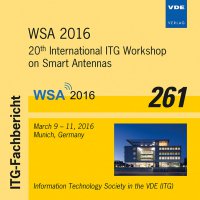Tensor-Based Approach for Time-Delay Estimation
Konferenz: WSA 2016 - 20th International ITG Workshop on Smart Antennas
09.03.2016 - 11.03.2016 in München, Deutschland
Tagungsband: WSA 2016
Seiten: 7Sprache: EnglischTyp: PDF
Persönliche VDE-Mitglieder erhalten auf diesen Artikel 10% Rabatt
Autoren:
Hammoud, Bilal; Antreich, Felix (German Aerospace Center (DLR), Institute for Communications and Navigation, Wessling, Germany)
Nossek, Josef A.; Nossek, Josef A. (Institute for Circuit Theory and Signal Processing, Technical University Munich, Munich, Germany)
Costa, Joao Paulo C. L. da (Department of Electrical Engineering, University of Brasília (UnB), Brasília, Distrito Federal, Brazil)
Almeida, Andre L. F. de (Department of Teleinformatics Engineering, Federal University of Ceará (UFC), Fortaleza, Brazil)
Inhalt:
Multipath (ML) signals reflected from the surrounding objects of a Global Navigation Satellite Systems (GNSS) receiver lead to a bias in the time-delay estimation of the line-of-sight (LOS) signal. In several cases, this bias is reflected as errors in the pseudo-range estimation of the receiver. In this paper, we derive a tensor-based filtering approach using an antenna array and a compression method based on canonical components (CC) with a bank of signal matched correlators in order to mitigate multipath and to estimate the time-delay of the LOS signal of a GNSS satellite. First, we resort to multidimensional filtering based on the principal singular vectors of the multi-dimensional data. In order to separate highly correlated signal components in the multi-dimensional signal subspace methods like forward-backward averaging (FBA), spatial smoothing (SPS), and the recently developed expanded spatial smoothing (SPS-EXP) are applied. Afterwards, time-delay estimation of the LOS signal is performed with a simple interpolation based on the multi-dimensional filtered cross-correlation values of the bank of correlators. An advantage of such an approach is that no multidimensional nonlinear problems need to be solved and also no model order estimation is required.


